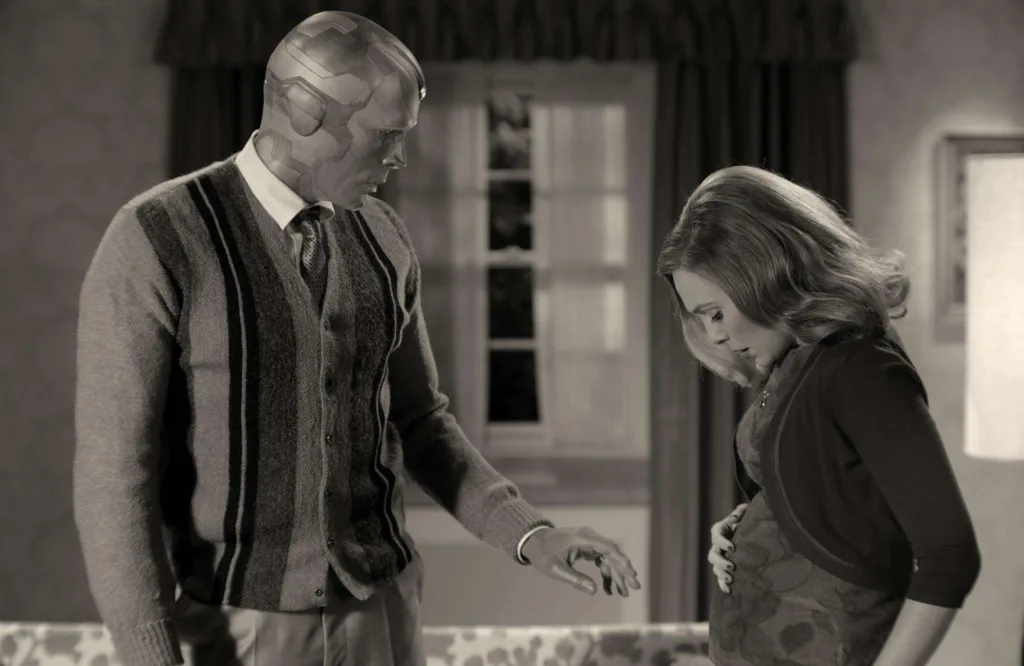Marvel’s latest television miniseries, WandaVision, has been making waves in the entertainment industry for its unique approach to storytelling. The show revolves around the characters of Wanda Maximoff, also known as the Scarlet Witch, and Vision, as they attempt to lead a seemingly normal life in the town of Westview, New Jersey.
One of the most interesting aspects of the show is its use of black and white cinematography. The first two episodes of WandaVision were filmed entirely in black and white, as a tribute to classic sitcoms from the golden age of television. The show’s creators wanted to create an atmosphere that was reminiscent of shows like I Love Lucy and The Dick Van Dyke Show, and they certainly succeeded in doing so.
The decision to film in black and white was a bold one, but it paid off in terms of the show’s oveall aesthetic. The monochromatic color palette adds a sense of timelessness to the show, and gives it a sense of nostalgia that is difficult to replicate in full color.
Despite its black and white appearance, however, WandaVision is far from a one-note show. The trailers and promos for the series show a wide range of action and vibrant colors, indicating that the black and white cinematography is only one aspect of the show’s diverse visual style.
In fact, the third episode of the series, titled “Now in Color,” marks a significant departure from the black and white aesthetic of the first two episodes. The episode introduces color in a dramatic fashion, as Wanda and Vision’s world suddenly becomes vibrant and full of life. This shift in visual style is indicative of the show’s willingness to experiment and take risks, and it is sure to keep viewers on their toes throughout the rest of the season.
WandaVision’s use of black and white cinematography is a testament to the creativity and vision of its creators. By paying homage to classic sitcoms while also pushing the boundaries of what is possible in modern television, the show has quickly become one of the most talked-about series of the year. Whether you’re a fan of superhero stories or simply appreciate great storytelling, WandaVision is definitely worth a watch.
Is The Entire WandaVision Black And White?
The entire WandaVision show is not black and white. Marvel has confirmed that only a few of the episodes were filmed in black and white. The trailers and promos for the show also showcase scenes filmed in vibrant colors, indicating that the entire series won’t be monochromatic.

Why Is Everything Black And White In WandaVision?
The decision to present the fist two episodes of WandaVision in black-and-white was a creative choice made by the show’s creators as a tribute to classic sitcoms of the past. The show is set in a world that is heavily influenced by American television from the 1950s and 60s, which were predominantly presented in black-and-white due to technological limitations of the time. This choice not only adds a nostalgic feel to the show but also serves to highlight the stark contrast between the idyllic suburban setting and the underlying mystery and darkness that lie beneath the surface. Additionally, the use of color in the final moments of episode 2 serves as a powerful visual cue to signify a shift in the narrative and represents a major turning point in the story.
Why Is WandaVision Episode 1 In Black And White?
WandaVision episode 1 is in black and white as it was intended to be a tribute to the golden age of television. The creators of the show wanted to pay homage to classic sitcoms such as “I Love Lucy” and “Bewitched” by filming the first episode in black and white. This was a deliberate choice to transport viewers back to the 1950s and 1960s era of television, whee black and white was the norm. Moreover, the use of a live studio audience and classic sitcom tropes added to the nostalgic feel of the episode. the black and white aesthetic was a creative decision made by the show’s creators to capture the essence of classic television and add to the unique and innovative nature of the show.
What Episode Does WandaVision Stop Being Black And White?
The American television miniseries WandaVision starts off in black and white and progressively transitions to color. The shift from black and white to color occurs in the tird episode, titled “Now in Color.” This episode marks a significant change in the series as the main characters, Wanda Maximoff / Scarlet Witch and Vision, find themselves in a colorful, 1970s-inspired setting. The episode showcases the couple’s attempts to hide their powers while living a seemingly perfect suburban life in the town of Westview, New Jersey. “Now in Color” serves as a pivotal point in the series and sets the stage for the following episodes.
Conclusion
Marvel’s WandaVision is a unique and intriguing television miniseries that pays tribute to the golden age of television while also incorporating the beloved characters of Wanda Maximoff and Vision from the Marvel Comics universe. The first two episodes were filmed in classic black and white, creating a nostalgic and charming sitcom setting that added to the show’s overall appeal. The third episode introduced vibrant colors into the mix, signaling a shift in the narrative and adding to the mystery surrounding the couple’s idyllic suburban life. WandaVision is a must-watch for fans of the Marvel Cinematic Universe and anyone lookig for a fresh and inventive take on the superhero genre.
